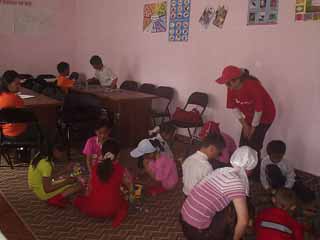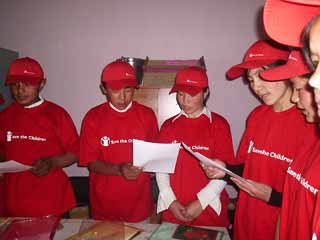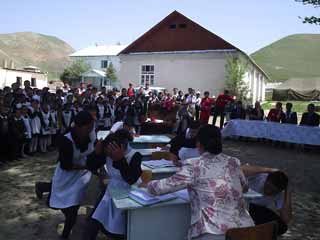Safe play in an earthquake zone in Kyrgyzstan
Tolkun Jukusheva
In an emergency situation, relief and reconstruction work focuses on basic necessities such as food, water and shelter. Children’s play needs may be forgotten, yet they are central to the development of every child. In this article, Tolkun explains how Save the Children helped to establish safe play areas for children in two affected villages – Karasogot and Temirkoruk. This collaborative effort with the Ministry of Emergency Situation, district education departments, school administrations, community members, adults and children became so popular it has continued even after the emergency.
Kyrgyzstan is located in Central Asia among many ‘young’ mountains which are still growing. This causes more than 2,000 earthquake tremors each year. After a large earthquake in the south of Kyrgyzstan in January 2008, Save the Children decided to implement a project called “Child Protection in the Aftermath of the Earthquake in Kyrgyzstan”, funded by the UK Department for International Development. The project aimed to reduce the impact of the earthquake on the lives of children and their families in affected villages through providing immediate relief and support to children.
What is a safe play area?
The creation of safe play areas is a key intervention within Save the Children’s emergency responses. The areas provide children with protected environments where they can participate in organised activities. Children play, socialise, learn, and express themselves as they rebuild their lives. This is a key intervention for protecting children from physical harm and psychosocial distress, and for helping them to continue learning and developing, both during and immediately after an emergency.
Each play area is equipped with toys, books, sports equipment, washing stands, temporary paddling pools, furniture, a CD player, etc. In Karasogot village, with support from the Ministry, two big shelters were provided for use as the safe play area and school kitchen. An old carpentry workshop was repaired with support and contributions from community members and teachers in Temirkoruk village.
What happens in the safe play areas?
The areas open at 9am and close at 5pm, and operate two shifts. They are closed on Saturdays. They are open to all children from 3 to 17 years old – younger children attend in the morning, older ones in the afternoon. Volunteers organise work and are on duty to supervise the children in the play areas.
Save the Children staff initially trained safe play area volunteers, parents and children on child rights, hygiene and sanitation, tolerance, effective communication, natural disasters, etc. Volunteer facilitators then conducted similar sessions with users of the play areas (children and parents).
Save the Children staff organised children’s games and competitions. We used ideas from a manual on ‘safe spaces’ by the American Red Cross, and games and activities compiled by an emergency education specialist from Save the Children US. Child-to-child approaches have also been used, through which children volunteer to organise games and competitions, and facilitate trainings, etc, with other children.
Community involvement
When we started to establish the safe play areas in the affected villages, community members didn’t like the idea. Many said they didn’t need playgrounds for children, they needed to rebuild their houses before winter and their children would help them with this. They said nobody would be able to use the play facilities or work as volunteers.

Volunteers and children in a safe play area
But we decided to start anyway, conducting training and organising games, and signing a collaboration agreement with the school administration and district education department. The local authorities helped us to organise meetings with community members and elderly people so that we could persuade them to change their attitude. Building a relationship with community members and local authorities is an essential step in establishing a project like this.
Once we had secured community support, children and parents were the main actors in implementing the project and they worked as volunteers in each safe play area. In both villages, 30 volunteers (21 children and 9 adults) were identified. All 30 received Save the Children’s training. Volunteers then developed the schedule of work, designed the area, informed other children about the project, and divided responsibilities among each other. During the opening ceremonies for the play areas, short plays about the earthquake were performed by volunteers and they talked about their work to promote safe play.

Young volunteers preparing activities
Volunteers help disabled children to use the play areas. Each volunteer is responsible for one street and they invite all the children from this street to attend. If children live far away their parents take it in turns to accompany them.
Volunteers also identify equipment needs and ‘play co-ordinators’ are appointed through an election process. Volunteers have also conducted a public awareness campaign on child rights, and community members have helped volunteers to run sport, drawing and essay-writing competitions for adults and children.

Children perform a play about the earthquake
The right to play
- States Parties recognize the right of the child to rest and leisure, to engage in play and recreational activities appropriate to the age of the child and to participate freely in cultural life and the arts.
- States Parties shall respect and promote the right of the child to participate fully in cultural and artistic life and shall encourage the provision of appropriate and equal opportunities for cultural, artistic, recreational and leisure activity.
Article 31, UN Convention on the Rights of the Child
Sustainability
Save the Children has handed over all equipment and relevant documents to the school administration, and each safe play area in Karasogot and Temirkoruk is continuing to run. Our volunteers are also continuing to work, even after the emergency period, because community members and children like the play areas. Now approximately 1,380 children from these two villages participate in the play activities.
Tolkun Jukusheva is the Monitoring and Evaluation Officer with Save the Children in Kyrgyzstan.
Contact:
27, Logvinenko Street
Bishkek,
Kyrgyzstan
Tel: +996 312 664839 / 664827
Email: tolkun@savechildren.kg
